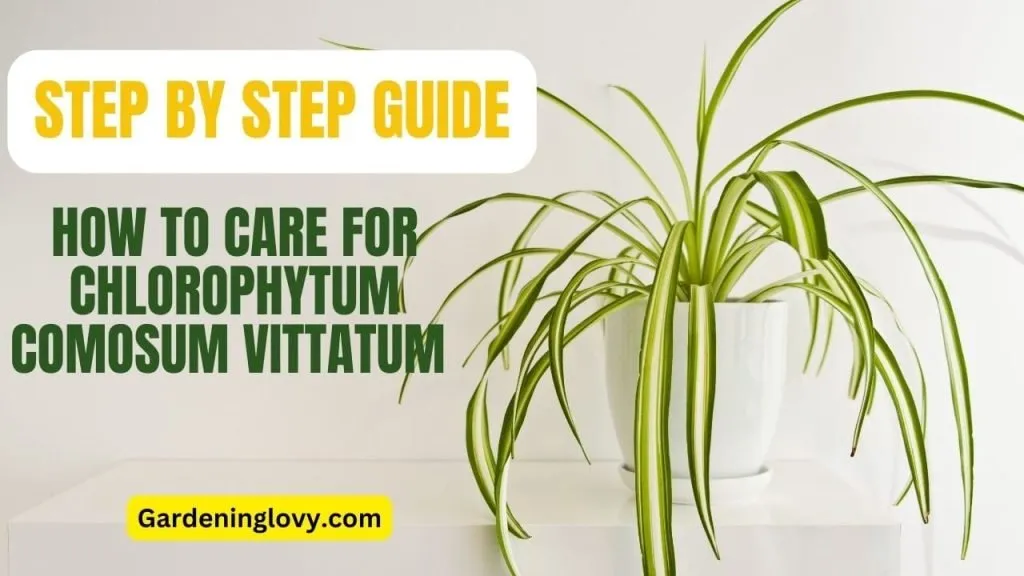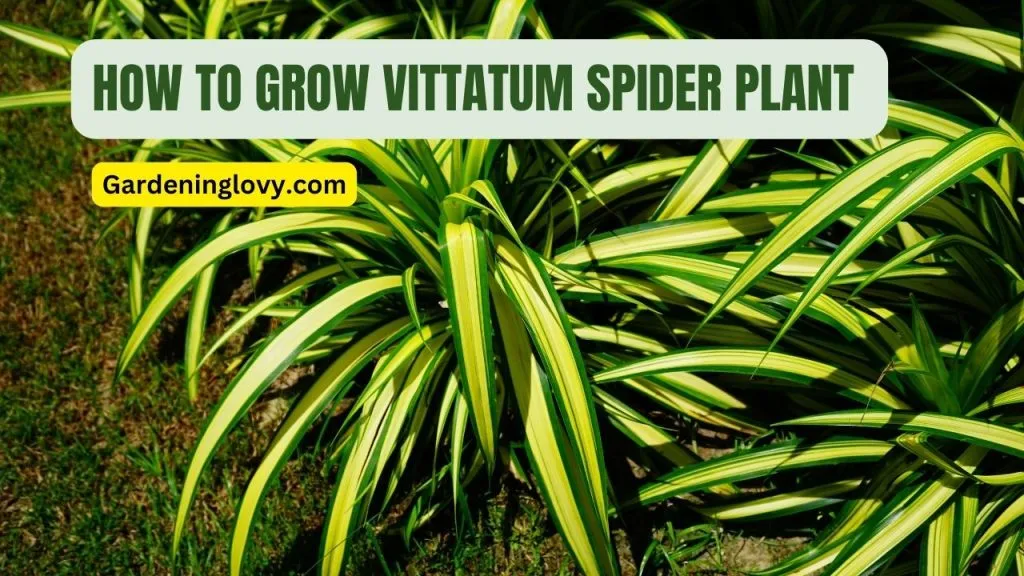If you love taking care of houseplants, you would definitely love the vittatum spider plant. Click here to see chlorophytum comosum vittatum care and grow guide!
Spider plants produce rosettes of tall, narrow, arching foliage. This foliage can be a solid green or white with green veining.
These attractive, low-maintenance houseplants were a favorite of Victorian-era homeowners, who particularly liked displaying them in hanging baskets.
How can you grow a beautiful plant like this? Continue reading and find out!

Understanding the Vittatum Spider Plant
Kenya and Tanzania are the birthplaces of the vittatum spider plant also known as “chlorophytum comosum vittatum “; however, it may be found throughout Africa.
It began in the early 1800s in Europe and made its way to North America around the century’s midpoint.
Spider plant is a common term for a plant with long, thin branches that trail down from the main plant and look like spider webs, thus the name.
They may reach three feet or longer and are densely covered with small white flowers.
Choosing the Right Location for Your Vittatum Spider Plant
When deciding where in your home to put your new vittatum spider plant, keep a few things in mind. Because they need indirect sunlight, a spot close to a window would be ideal for cultivating these plants.
It would help if you chose a spot for the plant that offers access to moist and well-drained soil since they like both circumstances.
Finally, since vittatum spider plants wilt with either excessive heat or cold, you should search for a location that falls somewhere in between.
If you keep these things in mind, deciding where to put your vittatum spider plant shouldn’t be too difficult.
Proper Lighting Requirements for Vittatum Spider Plants
Ensure your vittatum spider plant is in a spot that receives a lot of bright, indirect sunlight throughout the day. Because of this, it will be assured of getting the optimal quantity of light required for growth.
If you don’t have a bright, sunny spot in your home, you can grow a spider plant anywhere that has access to fluorescent lighting.
Keep the light source at least 12 inches from the plant to protect the leaves from burning in direct sunlight.
Watering Needs of Vittatum Spider Plants
The soil in its container must be kept consistently wet if a Vittatum spider plant is to thrive. It is advisable to water plants twice a day in the summer, in the morning and the evening, and to mist the leaves with water once or twice a day when development is rapid.
Throughout the spring and autumn, daily watering is sufficient. Watering should be done no more than once every four to five days throughout the winter.
Without consistent watering, it is likely to become a drab shade of yellow and lose most of its aesthetic appeal. Every time you water, ensure the soil is soaked, and all the water has drained out of the flowerpot’s drain hole.
Ideal Temperature and Humidity Levels for a Vittatum Spider Plant
When grown indoors, Vittatum spider plants do best between 60 and 80 degrees Fahrenheit (15 and 26 degrees Celsius), although they may survive down to 50 degrees Fahrenheit (10 degrees Celsius).
But, because of their sensitivity to unexpected temperature fluctuations, they shouldn’t be placed near air conditioning vents.
A tray of water near the plant or frequent misting might assist in maintaining a humid atmosphere since these plants like moderate to high humidity.
Maintaining a steady and pleasant climate for your Vittatum spider plant’s development is essential for its health.
Fertilizing Your Vittatum Spider Plant
If you want your Vittatum spider plant to thrive, you must fertilize it regularly. Throughout the growth season (usually spring through autumn), fertilizing your plant monthly is sufficient.
Spider plants thrive when given a diluted, all-purpose fertilizer that contains equal amounts of nitrogen, phosphorous, and potassium.
You might also use a slow-release fertilizer that releases its nutrients over months. Spider plants don’t like it when you over-fertilize them since this may cause burns and other problems.
Never fertilize a plant without first reading and following the box’s directions; always water properly after fertilizing to prevent root damage.
Chlorophytum Comosum Vittatum Care Tips
Besides being one of the most well-liked houseplants, the spider plant requires little care and maintenance.
Often reaching three feet in trailing foliage, they are well-known for this characteristic. The spider plant, kin to the more familiar peace lily, may be seen in Africa and Madagascar in their native settings.
If you want your spider plant to appear at its best, prune it regularly. Pruning encourages the growth of new branches and helps the plant keep its compact shape. Cut or shear spider plants as you see fit.
Just cut off a piece of the spider plant’s stem with two or more healthy leaves still connected to it, and you’ll have the makings of a new plant.
Soak the cutting in water or damp potting soil. In only a few weeks, you should be able to see the first phases of root development. After the cutting’s roots are approximately 5 to 8 cm long, you may move it to its pot.
The Right Soil for Vittatum Spider Plant
The Spider Plant, also known as Vittatum, is very adaptable to soil conditions and grows best in acidic to alkaline soil, loose and fertile, porous and well-drained, rich in humus, and has a pH value of 6-7.
While cultivating plants in containers, using just any old dirt as the substrate is not proper. Peat, leaf mold, or a mixture of the two, together with garden soil and river sand, might be used.
It just takes a very little fertilizer to serve as a basic fertilizer. There is also the option of using a 3:7 leaf mold to sandy soil combination as the culture medium.
Root rot may occur if water collects in a container with inadequate drainage and no air holes.
Repotting at least once every two years and switching up the soil annually can help your plant flourish and grow to its maximum potential.
Dealing with Common Pests and Diseases of Vittatum Spider Plants

Despite their resistance to diseases and pests, vittatum spider plants are susceptible to a few common problems. Such problems include aphids, mealybugs, spider mites, and root rot.
Insects, known as aphids, feed on plant sap and lack wings. Small size is characteristic of aphids. As a result, growth and leaf form may be slowed.
A small white insect called mealybug feeds on plant fluids and secretes honeydew, which may promote the establishment of sooty mold.
The mealybugs’ diet consists mostly of plant sap. Spider mites are tiny spider-like insects that live off plant sap and spin webs.
The leaves may develop stains or discoloration as a result of their presence. Root rot, a fungal disease, causes the plant’s roots to degenerate, which kills the plant.
An insecticidal soap or a neem oil spray may help eliminate pests, including aphids, mealybugs, and spider mites.
Improving drainage and eliminating diseased or damaged roots are possible treatments for root rot.
Repotting Your Vittatum Spider Plant
An important component of maintaining your Vittatum spider plant is repotting it. Since spider plants like to be somewhat root-bound, they seldom need to be repotted.
It is recommended to use a pot that is one size bigger than the one you are currently using and has drainage holes for repotting.
When transferring the plant to the new container, gently loosen the roots and discard any damaged or dead. Put in good quality potting soil that drains well and waters well.
Once you’ve repotted your plant, give it a few days to acclimate to its new home out of direct sunshine. Repotting it every few years is recommended to ensure the continued health and growth of your Vittatum spider plant.
Tips for Long-Term Vittatum Spider Plant Growth
A vittatum spider plant’s longevity and flourishing growth depend on your observance of a few simple guidelines. Make sure your plant always has access to enough bright, indirect sunlight.
Leaves produced will be strong and healthy because of this. Second, water your plant often, but avoid drowning it; a spider plant may not survive if it receives too much water.
Let the soil get completely dry between waterings. Lastly, once every few months, water your plant softly with a diluted fertilizer solution to stimulate new growth.
Planting the Vittatum Spider Plant
Plant in soil or a potting mix with good drainage. Spider plants prefer a consistent moisture level to either be too dry or too wet.
Plants need indirect light, but not too much. Spider plants’ leaves may easily burn in direct sunlight, discoloring and browning at the leaf margins.
In a short amount of time, spider plants may outgrow their containers. Your spider plant should be repotted every other year at the absolute least.
Summer is the best time to put a spider plant outside as an annual. They are most attractive when planted along the border of a pot or bed and shielded from the sun.
Conclusion
It takes very little care to ensure the success of a vittatum spider plant.
You can ensure that it always looks its best by giving your Vittatum spider plant plenty of light, water, fertilizer, and the odd pruning.
It’s not only aesthetically pleasing, but it also helps keep the air in the home clean. The Vittatum Spider Plant is a great option for a low-maintenance houseplant that still looks great after a few years.

My name is Olivia, and I live in the United States and love having plants in my garden. Lots of plants are there on my balcony, indoor and outdoor garden also. Here I am trying to share useful gardening tips, how to grow and care for various plants, etc.
